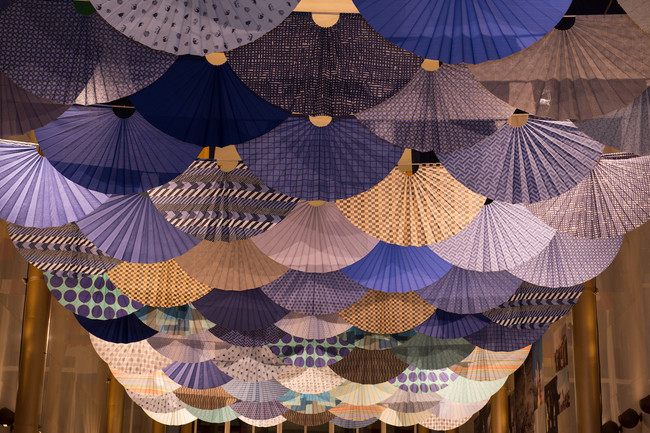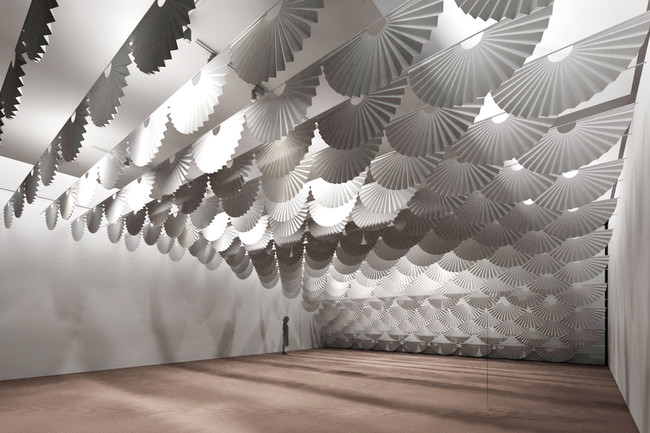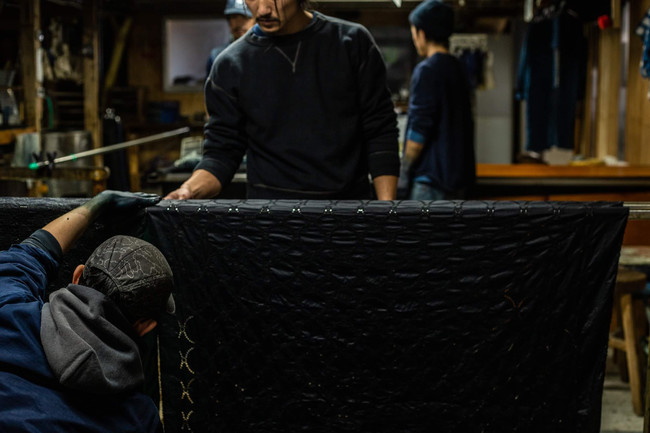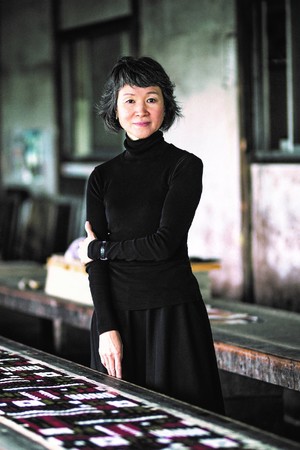Reiko Sudo, director of textile design studio NUNO, whose work has been exhibited in museums around the world, will be participating in the exhibition "Six Solo Exhibitions" at the Museum of Modern Art, Ibaraki, where one of her representative works, "Fan Dance," will be exhibited in Japan for the first time. As a new venture, this exhibition will provide a spatial experience with added sound effects in collaboration with Kyoto-based art/design unit Softpad. This will be Sudo's first large-scale exhibition in Japan since "Koinobori Now!", which was held at the National Art Center, Tokyo in 2018.
 Reiko Sudo, Fan Dance, 2017, installation view at the John F. Kennedy Center for the Performing Arts. Photo: Margot Schulman
Reiko Sudo, Fan Dance, 2017, installation view at the John F. Kennedy Center for the Performing Arts. Photo: Margot Schulman
Softpad is in charge of sounddesignfor a new version of Fan Dance
Sudo Reiko first presented Fan Dance, a large-scale installation in which gigantic fans made from textiles fill the space, at an exhibition commemorating the 100th anniversary of President Trump's birth held at the John F. Kennedy Center for the Performing Arts in Washington, D.C. in 2017. The work, which evoked a great response for its dynamic spatial expression and the rich and colorful textures of the textiles, has since been exhibited at the British art museum Compton Verney, which opened earlier this year, and has now developed into this exhibition.
 Exhibition design for this exhibition (C) Tashiro Masafumi Design Room
Exhibition design for this exhibition (C) Tashiro Masafumi Design Room
In this, the first of its kind in Japan, "Dance of the Fans" features 204 fabric fans arranged to cover the exhibition room from floor to ceiling, creating a composition that, combined with the dynamic rhythm of colors, evokes the feeling of a large, surging wave, a sense of flow. The spatial design is based on the ideas of French architect Adrien Gardère, with whom Sudo has previously collaborated, but this time Sudo himself visited the museum where the exhibition is being held and, based on his spatial experience there, created the design together with NUNO member Kazuhiro Ueno. Additionally, for the first time in a Japanese version of Fan Dance, Sudo has incorporated a wave-themed soundscape using Softpad, challenging himself to create a new viewing experience in which textiles and sound organically resonate with one another. This experiment explores the possibilities of real-world spatial exhibitions, especially in a time when digital viewing of artworks has become the norm amid the COVID-19 pandemic.
A Blue Fan Expresses the Ambiguity of Japanese Culture
The fan, the motif of this work, was invented in Japan during the Heian period, and its "spreading" shape has made it an essential part of celebratory occasions in Japan. Since ancient times, the fan has played a variety of roles beyond its original function of fanning, including as a drinking cup in kyogen, as chopsticks for slurping soba noodles in rakugo, and as a barrier symbolized by placing it in front of one's knees at the tea ceremony. Sudo has used the fan in his work as a symbol of the ambiguity of Japanese culture, expressing it in the color blue, which has also long been a part of Japanese life. Lafcadio Hearn, who visited Japan in 1890, later wrote the following about his impressions of Japan: "The houses under blue roofs are small, the shops with blue noren curtains are small, and the people wearing blue kimonos are small." Japan was undoubtedly a blue country.
![NUNO textile used on the fan,]() NUNO textile used on the fan, "Tiggy" 2003
NUNO textile used on the fan, "Tiggy" 2003
![NUNO textile used on the fan,]() NUNO textile used on a fan, "Glitter and Peony Snow," 2017
NUNO textile used on a fan, "Glitter and Peony Snow," 2017
Photo: Masayuki Hayashi
![NUNO textile used on a fan,]() NUNO textile used on a fan, "Swing Square," 2008
NUNO textile used on a fan, "Swing Square," 2008
Photo: Masayuki Hayashi
NUNO's work connects tradition withthelatesttechnology
The textiles used for the fans were carefully selected from the NUNO archives, and each one reflects the fruits of Sudo's long-standing experimental and ambitious textile-making endeavors. Through repeated collaborations with outstanding textile producers across Japan, Sudo's creations, which demonstrate a deep understanding of traditional techniques while freely moving between the worlds of cutting-edge technology and contemporary design, have greatly expanded the concept of textiles. Even in the process of dyeing the fabric blue for this piece, Sudo maintains a style that flexibly incorporates a variety of methods, both old and new, from genuine indigo dyeing by BUAISOU in Tokushima to indigo dyeing in the jeans-producing region of Okayama, to the latest heat transfer techniques.
 The process of authentic indigo dyeing, commissioned to a workshop in Tokushima. Photo provided by BUAISOU
The process of authentic indigo dyeing, commissioned to a workshop in Tokushima. Photo provided by BUAISOU
Initially, this exhibition was planned to tour the works shown in the UK, but due to changes in the exhibition schedule in the UK caused by the spread of the coronavirus, the works did not arrive in time and there was a risk that the exhibit would not be able to be exhibited. Amidst the coronavirus pandemic, Sudo decided to create new works in a short period of time, and this exhibition was made possible. It reflects Sudo's desire to inspire people living in the same era as him through his works, even in these difficult times.
Exhibition Title: Six Solo Exhibitions2020
Venue: Ibaraki Museum of Modern Art
Dates: Tuesday, November 3, 2020 (National Holiday) – Sunday, December 20, 2020
"Six Solo Exhibitions" introduces active artists with ties to Ibaraki. This third installment will feature six solo exhibitions showcasing works by artists who engage with physical materials in their creative endeavors in an age of increasing digitalization. Reiko Sudo was selected because she was born in Ishioka City, Ibaraki Prefecture.
*To prevent the spread of COVID-19, this exhibition will be introducing online numbered tickets with specified dates and times.
*For more detailed and up-to-date information on the exhibition, please see below. http://www.modernart.museum.ibk.ed.jp/exhibition/kikaku/index.html
Reiko Sudo Artist Talk: Tuesday, November 3rd (National Holiday) 14:00 - 15:00 (Advance booking required)
An artist talk in which the artist herself will talk about her works and stories behind their creation. Please see below for further details.
http://www.modernart.museum.ibk.ed.jp/event/lecture/index.html
 Reiko Sudo Photo Tamura Kosuke
Reiko Sudo Photo Tamura Kosuke
Reiko Sudo / Reiko Sudo
Born in Ibaraki Prefecture. After working as an assistant in the textile laboratory of the Department of Industrial, Craft and Craft Design at Musashino Art University, she participated in the establishment of Nuno Co., Ltd. She is currently a director and design director. She received an honorary master's degree from University College of Art and Design in the UK. Since 2019 she has been a professor emeritus at Tokyo Zokei University. Since 2008, she has worked on fabric planning and development for Ryohin Keikaku and provided design advice to the Tsuruoka Textile Industrial Cooperative and Az Co., Ltd. In 2016, she joined the MUJI Advisory Board. She has received awards including the Mainichi Design Award, Roscoe Award, and JID Division Award. She creates new textiles, utilizing traditional Japanese dyeing and weaving techniques as well as cutting-edge technology. Her works have received high acclaim both in Japan and abroad, and are included in the permanent collections of museums such as the Museum of Modern Art in New York, the Metropolitan Museum of Art, the Museum of Fine Arts, Boston, the Victoria & Albert Museum, and the National Museum of Modern Art, Tokyo Crafts Gallery. In 2018, she held a solo exhibition, "Koinobori Now!" at the National Art Center, Tokyo, and in 2019, she held "Sudo Reiko: Making NUNO Textiles" at CHAT (Centre for Heritage, Arts and Textile) in Hong Kong. The exhibition is scheduled to travel to Japan House in London in spring 2021. Her representative works include textile designs for the Mandarin Oriental Tokyo and the Tokyo American Club. www.nuno.com
Softpad/ Softpad
An art/design unit based in Kyoto (creative members: Ichiro Awazu, Tomohiro Kamishiba, Teruyasu Okumura, Hajime Takeuchi, Hiromasa Tomari, Hiroshi Toyama, and Takuya Minami). Their creative work transcends genres, exploring the boundaries and intersections of each medium, including installation, performance, sound, and design.
Fan Dance: Sound Design: Takuya Minami, Hiroshi Toyama, Ichiro Awazu
Click here for company press release details
 Reiko Sudo, Fan Dance, 2017, installation view at the John F. Kennedy Center for the Performing Arts. Photo: Margot Schulman
Reiko Sudo, Fan Dance, 2017, installation view at the John F. Kennedy Center for the Performing Arts. Photo: Margot SchulmanSoftpad is in charge of sounddesignfor a new version of Fan Dance
Sudo Reiko first presented Fan Dance, a large-scale installation in which gigantic fans made from textiles fill the space, at an exhibition commemorating the 100th anniversary of President Trump's birth held at the John F. Kennedy Center for the Performing Arts in Washington, D.C. in 2017. The work, which evoked a great response for its dynamic spatial expression and the rich and colorful textures of the textiles, has since been exhibited at the British art museum Compton Verney, which opened earlier this year, and has now developed into this exhibition.
 Exhibition design for this exhibition (C) Tashiro Masafumi Design Room
Exhibition design for this exhibition (C) Tashiro Masafumi Design RoomIn this, the first of its kind in Japan, "Dance of the Fans" features 204 fabric fans arranged to cover the exhibition room from floor to ceiling, creating a composition that, combined with the dynamic rhythm of colors, evokes the feeling of a large, surging wave, a sense of flow. The spatial design is based on the ideas of French architect Adrien Gardère, with whom Sudo has previously collaborated, but this time Sudo himself visited the museum where the exhibition is being held and, based on his spatial experience there, created the design together with NUNO member Kazuhiro Ueno. Additionally, for the first time in a Japanese version of Fan Dance, Sudo has incorporated a wave-themed soundscape using Softpad, challenging himself to create a new viewing experience in which textiles and sound organically resonate with one another. This experiment explores the possibilities of real-world spatial exhibitions, especially in a time when digital viewing of artworks has become the norm amid the COVID-19 pandemic.
A Blue Fan Expresses the Ambiguity of Japanese Culture
The fan, the motif of this work, was invented in Japan during the Heian period, and its "spreading" shape has made it an essential part of celebratory occasions in Japan. Since ancient times, the fan has played a variety of roles beyond its original function of fanning, including as a drinking cup in kyogen, as chopsticks for slurping soba noodles in rakugo, and as a barrier symbolized by placing it in front of one's knees at the tea ceremony. Sudo has used the fan in his work as a symbol of the ambiguity of Japanese culture, expressing it in the color blue, which has also long been a part of Japanese life. Lafcadio Hearn, who visited Japan in 1890, later wrote the following about his impressions of Japan: "The houses under blue roofs are small, the shops with blue noren curtains are small, and the people wearing blue kimonos are small." Japan was undoubtedly a blue country.
Photo: Masayuki Hayashi
Photo: Masayuki Hayashi
NUNO's work connects tradition withthelatesttechnology
The textiles used for the fans were carefully selected from the NUNO archives, and each one reflects the fruits of Sudo's long-standing experimental and ambitious textile-making endeavors. Through repeated collaborations with outstanding textile producers across Japan, Sudo's creations, which demonstrate a deep understanding of traditional techniques while freely moving between the worlds of cutting-edge technology and contemporary design, have greatly expanded the concept of textiles. Even in the process of dyeing the fabric blue for this piece, Sudo maintains a style that flexibly incorporates a variety of methods, both old and new, from genuine indigo dyeing by BUAISOU in Tokushima to indigo dyeing in the jeans-producing region of Okayama, to the latest heat transfer techniques.
 The process of authentic indigo dyeing, commissioned to a workshop in Tokushima. Photo provided by BUAISOU
The process of authentic indigo dyeing, commissioned to a workshop in Tokushima. Photo provided by BUAISOUInitially, this exhibition was planned to tour the works shown in the UK, but due to changes in the exhibition schedule in the UK caused by the spread of the coronavirus, the works did not arrive in time and there was a risk that the exhibit would not be able to be exhibited. Amidst the coronavirus pandemic, Sudo decided to create new works in a short period of time, and this exhibition was made possible. It reflects Sudo's desire to inspire people living in the same era as him through his works, even in these difficult times.
Exhibition Title: Six Solo Exhibitions2020
Venue: Ibaraki Museum of Modern Art
Dates: Tuesday, November 3, 2020 (National Holiday) – Sunday, December 20, 2020
"Six Solo Exhibitions" introduces active artists with ties to Ibaraki. This third installment will feature six solo exhibitions showcasing works by artists who engage with physical materials in their creative endeavors in an age of increasing digitalization. Reiko Sudo was selected because she was born in Ishioka City, Ibaraki Prefecture.
*To prevent the spread of COVID-19, this exhibition will be introducing online numbered tickets with specified dates and times.
*For more detailed and up-to-date information on the exhibition, please see below. http://www.modernart.museum.ibk.ed.jp/exhibition/kikaku/index.html
Reiko Sudo Artist Talk: Tuesday, November 3rd (National Holiday) 14:00 - 15:00 (Advance booking required)
An artist talk in which the artist herself will talk about her works and stories behind their creation. Please see below for further details.
http://www.modernart.museum.ibk.ed.jp/event/lecture/index.html
 Reiko Sudo Photo Tamura Kosuke
Reiko Sudo Photo Tamura KosukeReiko Sudo / Reiko Sudo
Born in Ibaraki Prefecture. After working as an assistant in the textile laboratory of the Department of Industrial, Craft and Craft Design at Musashino Art University, she participated in the establishment of Nuno Co., Ltd. She is currently a director and design director. She received an honorary master's degree from University College of Art and Design in the UK. Since 2019 she has been a professor emeritus at Tokyo Zokei University. Since 2008, she has worked on fabric planning and development for Ryohin Keikaku and provided design advice to the Tsuruoka Textile Industrial Cooperative and Az Co., Ltd. In 2016, she joined the MUJI Advisory Board. She has received awards including the Mainichi Design Award, Roscoe Award, and JID Division Award. She creates new textiles, utilizing traditional Japanese dyeing and weaving techniques as well as cutting-edge technology. Her works have received high acclaim both in Japan and abroad, and are included in the permanent collections of museums such as the Museum of Modern Art in New York, the Metropolitan Museum of Art, the Museum of Fine Arts, Boston, the Victoria & Albert Museum, and the National Museum of Modern Art, Tokyo Crafts Gallery. In 2018, she held a solo exhibition, "Koinobori Now!" at the National Art Center, Tokyo, and in 2019, she held "Sudo Reiko: Making NUNO Textiles" at CHAT (Centre for Heritage, Arts and Textile) in Hong Kong. The exhibition is scheduled to travel to Japan House in London in spring 2021. Her representative works include textile designs for the Mandarin Oriental Tokyo and the Tokyo American Club. www.nuno.com
Softpad/ Softpad
An art/design unit based in Kyoto (creative members: Ichiro Awazu, Tomohiro Kamishiba, Teruyasu Okumura, Hajime Takeuchi, Hiromasa Tomari, Hiroshi Toyama, and Takuya Minami). Their creative work transcends genres, exploring the boundaries and intersections of each medium, including installation, performance, sound, and design.
Fan Dance: Sound Design: Takuya Minami, Hiroshi Toyama, Ichiro Awazu
Click here for company press release details
The press releases featured in this article have been provided by PR TIMES, Inc. and are reproduced verbatim. FASHION HEADLINE does not recommend the products or services featured, nor does it guarantee the contents of the press releases. For inquiries regarding the content of the publications, please contact PR TIMES Inc. directly (https://prtimes.jp/).
















